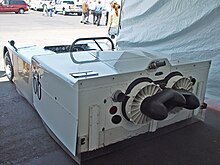Chaparral 2J
It was integrated with the suspension system so the bottom of the skirt would maintain a distance of one inch from the ground regardless of g-forces or anomalies in the road surface.
[9][10][11][12][13] The 2J competed in the Can-Am series and qualified at least two seconds quicker than the next fastest car, but mechanical problems limited its success.
Although originally approved by the SCCA, they succumbed to pressure from other teams who argued that the fans constituted "movable aerodynamic devices".
The engine overall was capable of producing 680 brake horsepower (510 kW) at 7,000 revolutions per minute, with the max speed of roughly 360 kilometres per hour (220 mph).
[citation needed] A similar fan was used in Formula One eight years later on the Brabham BT46B, which won the 1978 Swedish Grand Prix; the company reverted to the fanless BT46 soon afterward due to concern for a rules violation.


